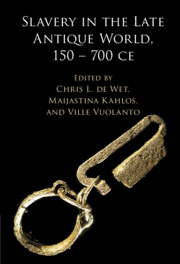Book contents
- Slavery in the Late Antique World, 150–700 CE
- Slavery in the Late Antique World, 150–700 CE
- Copyright page
- Contents
- Figures
- Tables
- Contributors
- Preface
- A Note on Abbreviations and Sources Used
- Introduction Late Antique Studies and the New Polyphony for Slave Studies
- Part I Moral and Symbolic Values of Slavery
- Part II Slavery, Cultural Discourses, and Identity
- Part III Slavery, Social History, and the Papyrological and Epigraphical Sources
- Part IV Social and Religious Histories of Slavery on the Borders of the Empire and Beyond
- 12 Slavery among the Visigoths
- 13 Sinner, Slave, Bishop, Saint: The Social and Religious Vicissitudes of St Patrick
- 14 Slave Boys in Paradise? The Text of the Quran and Its Later Exegetes
- Bibliography
- Index
12 - Slavery among the Visigoths
from Part IV - Social and Religious Histories of Slavery on the Borders of the Empire and Beyond
Published online by Cambridge University Press: 27 January 2022
- Slavery in the Late Antique World, 150–700 CE
- Slavery in the Late Antique World, 150–700 CE
- Copyright page
- Contents
- Figures
- Tables
- Contributors
- Preface
- A Note on Abbreviations and Sources Used
- Introduction Late Antique Studies and the New Polyphony for Slave Studies
- Part I Moral and Symbolic Values of Slavery
- Part II Slavery, Cultural Discourses, and Identity
- Part III Slavery, Social History, and the Papyrological and Epigraphical Sources
- Part IV Social and Religious Histories of Slavery on the Borders of the Empire and Beyond
- 12 Slavery among the Visigoths
- 13 Sinner, Slave, Bishop, Saint: The Social and Religious Vicissitudes of St Patrick
- 14 Slave Boys in Paradise? The Text of the Quran and Its Later Exegetes
- Bibliography
- Index
Summary
The question of Visigothic slavery has generally been treated in the context of larger studies on the Visigoths or of the Mediterranean economy rather than studies devoted to slavery. Even when it has been examined as a thing unto itself, it has tended to get folded into larger narratives of the development of social relations in the early Middle Ages. Marxist historians, such as Abilio Barbero, Marcelo Vigil, and Chris Wickham, have attempted to fit the evidence into a historical materialist narrative that posits a decline of slavery and slaveholding in the post-Roman world as states contracted and serfs or peasants replaced slaves as the primary agricultural producers. This narrative has been countered by French social historians, especially Georges Duby and Pierre Bonnassie, who argued that slavery continued to predominate in the early medieval West, giving way to serfdom only in the tenth century.
- Type
- Chapter
- Information
- Slavery in the Late Antique World, 150 – 700 CE , pp. 251 - 280Publisher: Cambridge University PressPrint publication year: 2022
Accessibility information
- 1
- Cited by

